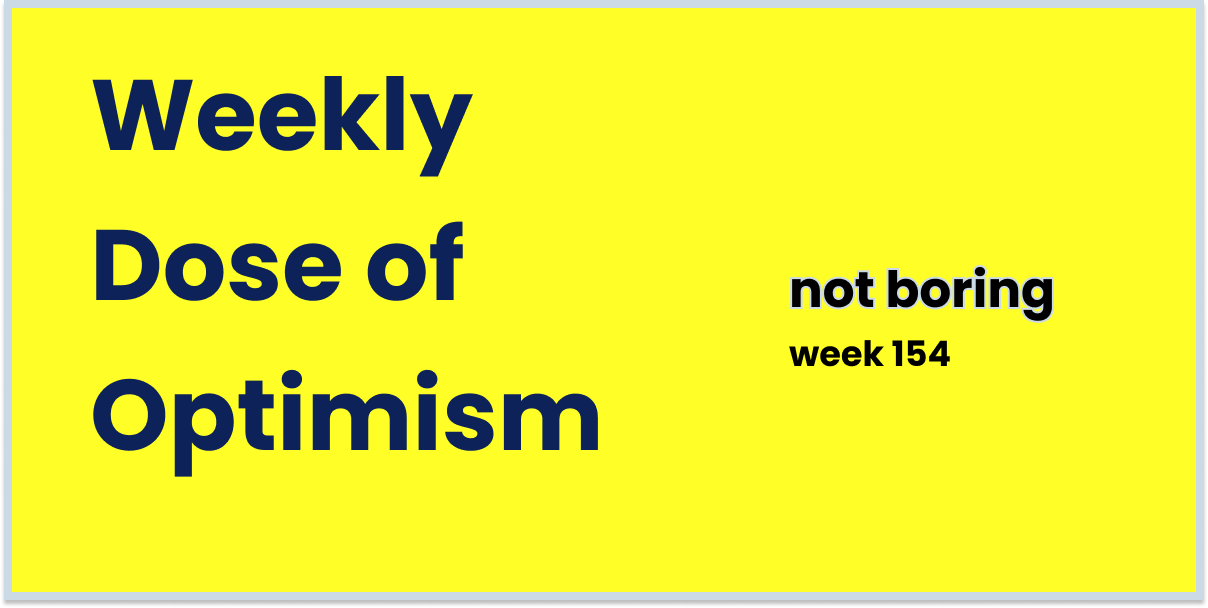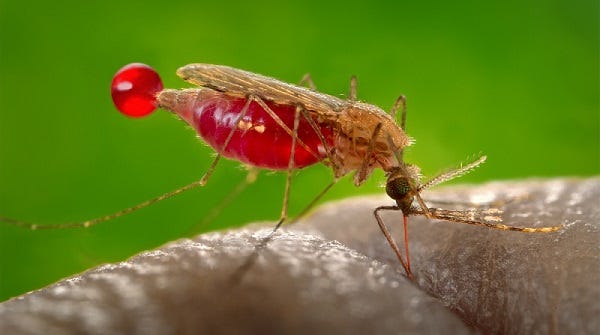Weekly Dose of Optimism #154
AI Action Plan, Aeneas, Genome Engineering, Male Contraceptive, FREP1, Zach Dell, New York
Hi friends 👋 ,
Happy Friday and welcome back to our 154th Weekly Dose of Optimism. Solid week in this neck of the woods; some AI news, a healthy dose of biotech updates, and a slate of solid content. Just another pretty astounding week that we’ve become relatively accustomed to.
Let’s get to it.
Today’s Weekly Dose is brought to you by… Stripe Startups
Every venture-backed company — yes, you — should work with Stripe Startups.
Stripe’s mission is to increase the GDP of the internet, and it’s working. Last year, 1.3% of global GDP flowed through Stripe, over $1.4 trillion and growing. 78% of the Forbes AI 50 use Stripe’s financial infrastructure to monetize faster, experiment with pricing, and grow revenue.
As I wrote in my original Deep Dive, Stripe’s strategy from the earliest days has been to make it as easy as possible for startups to begin accepting payments, and then grow with them as they get really big. With Stripe Startups, they’re making it even easier.
Stripe Startups is the company’s new program designed to support early-stage, venture-backed businesses as they build, iterate, and scale. Founders enrolled in Stripe Startups get access to credits to offset Stripe fees, expert insights, and a focused community of other founders building on Stripe.
You’re going to use Stripe anyway. Get the white-glove experience.
From The Trump Administration
America is in a race to achieve global dominance in artificial intelligence (AI). Winning this race will usher in a new era of human flourishing, economic competitiveness, and national security for the American people. Recognizing this, President Trump directed the creation of an AI Action Plan in the early days of his second term in office. Based on the three pillars of accelerating innovation, building AI infrastructure, and leading in international diplomacy and security, this Action Plan is America’s roadmap to win the race.
The White House dropped its much anticipated AI Action Plan this week. The draft, issued by the Office of Science and Technology Policy (OSTP), outlines a broad rethinking of how the U.S. should build, regulate, and lead in AI. It covers topics like upgrading infrastructure and investing in R&D to redefining how AI tools are tested and deployed. It emphasizes innovation-first policies like regulatory “sandboxes,” public-private data-sharing partnerships, and state-led experimentation zones. Notably, the proposal walks back some of the stricter oversight moves from the Biden era, favoring flexibility over federal mandates, and speed over caution.
The Action Plan has three key pillars:
Accelerate AI Innovation: support frontier research, foster public-private partnerships, and streamline regulatory pathways for AI development and deployment.
Build American AI Infrastructure: invest in compute, data access, energy, and workforce development to ensure broad, equitable access to AI capabilities.
Lead in International AI Diplomacy and Security: shape global norms, align allies, and safeguard against adversarial AI threats to uphold democratic values.
There are a bunch of specific actions against each of these pillars that are meant to animate these plans into the real world. We certainly should not count our chickens before they hatch, and there is a ton the U.S. needs to get right on this topic over the years and decades to come, but it seems like we’re in the pole position and the government is taking proactive steps to avoid fumbling the opportunity.
There is much to criticize about the Trump Administration. However, its handling of the ongoing AI boom has been pretty exceptional. First, the Administration put a highly competent tech operator (and decent podcaster) in charge of the operation in David Sacks, and surrounded him with friends like Dean Ball and Sriram Krishnan. And, because of that, this project seems to be moving with tech industry speed and is based more in real world practicality than theoretical regulation. In my view, getting AI right in this moment doesn’t excuse shortcomings elsewhere in the Trump White House, but could over the long arc of history prove to be the defining achievements of the administration, along with the nuclear EOs, crypto legislation, and this week’s deregulation of general aviation with the MOSAIC rule (see Eli Dourado’s tweet for more).
(2) Aeneas transforms how historians connect the past
From Google DeepMind
Introducing the first model for contextualizing ancient inscriptions, designed to help historians better interpret, attribute and restore fragmentary texts.
DeepMind released Aeneas, an AI model that helps historians restore, date, and geolocate ancient Roman inscriptions. Aeneas tackles fragmentary inscriptions, predicts missing words, estimates the date of origin within ±13 years, and suggests geographic provenance. Previously, this process was done relatively manually by historians and was slow and inconsistent.
Aeneas was trained on nearly 200,000 Latin texts and tested with 23 professional historians, with its top predictions being accepted 72% of the time and considered at least partially useful over 90% of the time. In one case, it re-dated the Res Gestae Divi Augusti (a first-person account of Emperor Augustus’ life and accomplishments) to AD 15, a timeline shift that could ripple through Roman history.
Much of human history remains fragmented, literally carved into weathered stone or buried in half-legible texts or burned up in ancient scrolls. Aeneas gives historians a new lens for interpreting what’s left behind.
Meta may have gotten Nat Friedman to build its models, but Google DeepMind turned Nat Friedman into a model. Your move, OpenAI.
(3) Genome engineering in biodiversity conservation and restoration
Oosterhout et al in Nature Reviews
Advances in genome engineering offer a transformative solution by enabling the targeted restoration of genetic diversity from historical samples, biobanks and related species. In this Perspective, we explore the integration of genome editing technologies into biodiversity conservation, and discuss the benefits and risks associated with genetic rescue via genome engineering.
Recently, we’ve covered how companies like Colossal Biosciences (and oddly enough, people like Peter Jackson) are working to de-extinct animals, like the moa and the wooly mammoth. That is some sci-fi level work and we’re excited to watch it progress. But there is still a ton of work to be done in preventing species from going extinct in the first place.
A new Nature Reviews paper outlines how gene editing could help save endangered species, not by bringing back extinct ones like the wooly mammoth, but by repairing the genetic damage in those still around. Many threatened species suffer from inbreeding, low genetic diversity, and harmful mutations that make them vulnerable to disease and changes in climate. The research proposes using targeted edits to restore lost genetic variation, remove harmful mutations, or introduce beneficial traits using CRISPR and other precise editing tools. In some cases, reference genomes from historical specimens or closely related species could guide the edits, effectively “rewinding” evolution to a healthier genetic baseline.
Gene editing isn’t not a replacement for habitat protection or traditional conservation, but it could be a useful complement. For species like the cheetah, Tasmanian devil, and climate-stressed corals (which Packy, maybe embarrassingly, was obsessed with as a kid), gene editing could offer a lifeline, helping them adapt faster than evolution normally allows.
In the words of the Million Dollar Man’s creators: We can rebuild them. We have the technology.
(4) First Hormone-Free Male Birth Control Pill Shown Safe in Early Human Trial
Hannah Seo in Scientific American
In the first clinical trial of its kind, a nonhormonal oral contraceptive that reversibly stops sperm production has just been deemed safe for human use. The daily pill, called YCT-529, blocks a vitamin A metabolite from binding to its receptor in the testes; this prevents the chain of gene-expression changes that are required to start the sperm-making process.
For the billions of men that are allergic to latex, there is hope on the way.
A male birth control pill just cleared its first major hurdle towards FDA approval. In a Phase 1 trial, YCT-529, a non-hormonal oral contraceptive, was shown to be safe and well-tolerated in vasectomized men. The plan is for the Boy Pill to be used by anyone, vasectomy or not, but given the newness of the drug, the researchers didn’t want to put long-term fertility at risk for those who might want to conceive at some point.
Unlike previous male pill candidates that relied on hormones (and brought unwanted side effects), YCT-529 targets a protein tied to vitamin A metabolism that’s crucial for sperm production. The trial determined the drug was safe, but was not meant to determine the drug’s efficacy (although results showed the drug achieved blood concentrations likely high enough to suppress fertility…which will need to be actually proven in a Phase 2 Trial).
I have some mixed feelings on all of this. First, it doesn’t seem fair to me that women alone are responsible for taking birth control. It takes two to tango, so having an option for male contraceptive makes sense to me. Second, IDK with all of the infertility issues men and women have faced over the last couple of decades, introducing a new male contraceptive, even if proven safe, feels a bit suss to me. I am not a tin foil hat guy, but I can’t imagine getting America’s men on the male pill is going to result in positive fertility outcomes.
My view on this stuff is that it’s better to have the scientific ability and optionality, than to not. For some people, this may be a tremendously useful and safe drug that prevents unwanted pregnancies. I, however, will not be hopping on this new little blue pill anytime soon.
(5) Driving a protective allele of the mosquito FREP1 gene to combat malaria
Li et al in Nature
Malaria remains a substantial global health challenge, causing approximately half a million deaths each year1. The mosquito fibrinogen-related protein 1 (FREP1) is required for malaria parasites to infect the midgut epithelium2. The naturally occurring FREP1Q allele has been reported to prevent parasite infection, while supporting essential physiological functions in the mosquito3. Here we generate congenic strains of Anopheles stephensi, edited to carry either the parasite-susceptible FREP1L224 or the putative-refractory FREP1Q224 alleles. The FREP1Q224 allele confers robust resistance to infection by both human and rodent malaria parasites, with negligible fitness costs.
The gene drives are here.
Mosquitoes aren’t inherently evil, but they do kill over 600,000 people a year by spreading malaria. It’s not intentional! They’re just doing what their genes tell them to do. Unfortunately, those genes make them highly effective carriers of one of the deadliest parasites on Earth.
But now, researchers have now engineered Anopheles stephensi mosquitoes to carry a naturally occurring gene variant, FREP1Q, that makes them much worse at transmitting malaria. FREP1 is a protein that helps Plasmodium parasites cross the mosquito’s gut and begin their life cycle. A single amino acid change (leucine to glutamine) disrupts that process. Mosquitoes with two copies of the FREP1Q allele showed drastically reduced infection rates for both human and rodent malaria parasites, with little to no impact on their health or reproduction.
Now we need this mosquitos to spread their updated genetic profile (keep them away from the YCT-529!).
The research team built a linked allelic-drive system, a subtle genetic trick that biases inheritance in favor of FREP1Q without resorting to a full gene drive. It’s a more targeted and potentially safer approach for use in the wild.
This method doesn’t kill mosquitoes or disrupt ecosystems. It just removes their ability to carry malaria. We’re all fine with some annoying mosquito bites here and there, just as long as those mosquito bites aren’t transmitting malaria and killing hundreds of thousands of people every year. I want to live in a world where all mosquitos carry the FREP1Q gene variant.
Bonuses:
Two great pieces of content we’d recommend:
Zach Dell on Invest Like The Best. Zach, Justin, and the team at Base are building a generational company, as we’ve written about here and here. Zach does a brilliant job explaining how the grid works (not easy to compress!), how Base works (not easy to compress!), and how he works. Great companies are made of special people building important products to fix big problems. This conversation shows off all three.
New York: A Documentary Film. I am obsessed with Ken Burns style PBS documentaries (it’s how I’ve managed to get so many chicks over the years) and I am obsessed with New York City. This 8 part, 17.5 hour documentary film combines those two obsessions. It covers the history of New York City from Henry Hudson’s exploration of the area in 1609 to the aftermath on 9/11 up through 2003. Understanding the history of the city makes living in it feel like your making history each day. Greatest city in the world, 416 years running.
Have a great weekend y’all.
Thanks to Stripe Startups for sponsoring. We’ll be back in your inbox next week.
Thanks for reading,
Packy + Dan








awesome stuff... AI regs, male birth control, malaria control... AWESOME
The Zach Dell link goes to the PBS NY documentary! Just a heads up.